Saunders Comprehensive NCLEX-RN Exam Review. UNIT 5 Maternity Nursing. 269 Page Ch 20-28, and includes Questions, Answers and Rationale.
Document Content and Description Below
THIS DOCUMENT CONTAINS THE FOLLOWING:
C H A P T E R 2 0: Reproductive System
C H A P T E R 2 1: Prenatal Period
C H A P T E R 2 2: Risk Conditions Related to Pregnancy
C H A P T E R 2 3: Labor a
...
nd Birth
C H A P T E R 2 4: Problems with Labor and Birth
C H A P T E R 2 5: Postpartum Period
C H A P T E R 2 6: Postpartum Complications
C H A P T E R 2 7: Care of the Newborn
C H A P T E R 2 8: Maternity and Newborn Medications
SAMPLE QUESTIONS BELOW
Practice Questions
184. The nurse is preparing to teach a prenatal class about fetal circulation. Which
statements should be included in the teaching plan? Select all that apply.
1. “The ductus arteriosus allows blood to bypass the fetal
lungs.”
2. “One vein carries oxygenated blood from the placenta to the
fetus.”
3. “The normal fetal heart beat range is 160 to 180 beats per
630minute in pregnancy.”
4. “Two arteries carry deoxygenated blood and waste products
away from the fetus to the placenta.”
5. “Two veins carry blood that is high in carbon dioxide and
other waste products away from the fetus to the placenta.”
185. The nursing instructor asks the student to describe fetal circulation,
specifically the ductus venosus. Which statement by the student indicates an
understanding of the ductus venosus?
1. “It connects the pulmonary artery to the aorta.”
2. “It is an opening between the right and left atria.”
3. “It connects the umbilical vein to the inferior vena cava.”
4. “It connects the umbilical artery to the inferior vena cava.”
186. A pregnant client tells the clinic nurse that she wants to know the sex of her
baby as soon as it can be determined. The nurse informs the client that she
should be able to find out the sex at 16 weeks’ gestation because of which
factor?
1. The appearance of the fetal external genitalia
2. The beginning of differentiation in the fetal groin
3. The fetal testes are descended into the scrotal sac
4. The internal differences in males and females become apparent
187. The nurse is performing an assessment on a client who is at 38 weeks’
gestation and notes that the fetal heart rate (FHR) is 174 beats per minute. On
the basis of this finding, what is the priority nursing action?
1. Document the finding.
2. Check the mother’s heart rate.
3. Notify the obstetrician (OB).
4. Tell the client that the fetal heart rate is normal.
188. The nurse is conducting a prenatal class on the female reproductive system.
When a client in the class asks why the fertilized ovum stays in the fallopian
tube for 3 days, what is the nurse’s best response?
1. “It promotes the fertilized ovum’s chances of survival.”
2. “It promotes the fertilized ovum’s exposure to estrogen and
progesterone.”
3. “It promotes the fertilized ovum’s normal implantation in the top
portion of the uterus.”
4. “It promotes the fertilized ovum’s exposure to luteinizing
hormone and follicle-stimulating hormone.”
189. The nursing instructor asks a nursing student to explain the characteristics of
the amniotic fluid. The student responds correctly by explaining which as
characteristics of amniotic fluid? Select all that apply.
1. Allows for fetal movement
2. Surrounds, cushions, and protects the fetus
3. Maintains the body temperature of the fetus
4. Can be used to measure fetal kidney function
6315. Prevents large particles such as bacteria from passing to the
fetus
6. Provides an exchange of nutrients and waste products
between the mother and the fetus
190. A couple comes to the family planning clinic and asks about sterilization
procedures. Which question by the nurse should determine whether this
method of family planning would be most appropriate?
1. “Have you ever had surgery?”
2. “Do you plan to have any other children?”
3. “Do either of you have diabetes mellitus?”
4. “Do either of you have problems with high blood pressure?”
191. The nurse should make which statement to a pregnant client found to have a
gynecoid pelvis?
1. “Your type of pelvis has a narrow pubic arch.”
2. “Your type of pelvis is the most favorable for labor and birth.”
3. “Your type of pelvis is a wide pelvis, but it has a short diameter.”
4. “You will need a cesarean section because this type of pelvis is not
favorable for a vaginal delivery.”
192. Which purposes of placental functioning should the nurse include in a
prenatal class? Select all that apply.
1. It cushions and protects the baby.
2. It maintains the temperature of the baby.
3. It is the way the baby gets food and oxygen.
4. It prevents all antibodies and viruses from passing to the
baby.
5. It provides an exchange of nutrients and waste products
between the mother and developing fetus.
193. A 55-year-old male client confides in the nurse that he is concerned about his
sexual function. What is the nurse’s best response?
1. “How often do you have sexual relations?”
2. “Please share with me more about your concerns.”
3. “You are still young and h
194. The nurse is providing instructions to a pregnant client who is scheduled for
664an amniocentesis. What instruction should the nurse provide?
1. Strict bed rest is required after the procedure.
2. Hospitalization is necessary for 24 hours after the procedure.
3. An informed consent needs to be signed before the procedure.
4. A fever is expected after the procedure because of the trauma to
the abdomen.
195. A pregnant client in the first trimester calls the nurse at a health care clinic
and reports that she has noticed a thin, colorless vaginal drainage. The nurse
should make which statement to the client?
1. “Come to the clinic immediately.”
2. “The vaginal discharge may be bothersome, but is a normal
occurrence.”
3. “Report to the emergency department at the maternity center
immediately.”
4. “Use tampons if the discharge is bothersome, but be sure to
change the tampons every 2 hours.”
196. A nonstress test is performed on a client who is pregnant, and the results of
the test indicate nonreactive findings. The primary health care provider
prescribes a contraction stress test, and the results are documented as
negative. How should the nurse document this finding?
1. A normal test result
2. An abnormal test result
3. A high risk for fetal demise
4. The need for a cesarean section
197. A rubella titer result of a 1-day postpartum client is less than 1:8, and a
rubella virus vaccine is prescribed to be administered before discharge. The
nurse provides which information to the client about the vaccine? Select all
that apply.
1. Breast-feeding needs to be stopped for 3 months.
2. Pregnancy needs to be avoided for 1 to 3 months.
3. The vaccine is administered by the subcutaneous route.
4. Exposure to immunosuppressed individuals needs to be
avoided.
5. A hypersensitivity reaction can occur if the client has an
allergy to eggs.
6. The area of the injection needs to be covered with a sterile
gauze for 1 week.
198. The nurse in a health care clinic is instructing a pregnant client how to
perform “kick counts.” Which statement by the client indicates a need for
further instruction?
1. “I will record the number of movements or kicks.”
2. “I need to lie flat on my back to perform the procedure.”
3. “If I count fewer than 10 kicks in a 2-hour period, I should count
the kicks again over the next 2 hours.”
4. “I should place my hands on the largest part of my abdomen and
665concentrate on the fetal movements to count the kicks.”
199. The nurse is performing an assessment of a pregnant client who is at 28
weeks of gestation. The nurse measures the fundal height in centimeters and
notes that the fundal height is 30 cm. How should the nurse interpret this
finding?
1. The client is measuring large for gestational age.
2. The client is measuring small for gestational age.
3. The client is measuring normal for gestational age.
4. More evidence is needed to determine size for gestational age.
200. The nurse is performing an assessment on a client who suspects that she is
pregnant and is checking the client for probable signs of pregnancy. The
nurse should assess for which probable signs of pregnancy? Select all that
apply.
1. Ballottement
2. Chadwick’s sign
3. Uterine enlargement
4. Positive pregnancy test
5. Fetal heart rate detected by a nonelectronic device
6. Outline of fetus via radiography or ultrasonography
201. A pregnant client is seen for a regular prenatal visit and tells the nurse that
she is experiencing irregular contractions. The nurse determines that she is
experiencing Braxton Hicks contractions. On the basis of this finding, which
nursing action is appropriate?
1. Contact the primary health care provider.
2. Instruct the client to maintain bed rest for the remainder of the
pregnancy.
3. Inform the client that these contractions are common and may
occur throughout the pregnancy.
4. Call the maternity unit and inform them that the client will be
admitted in a preterm labor condition.
202. A client arrives at the clinic for the first prenatal assessment. She tells the
nurse that the first day of her last normal menstrual period was October 19,
2020. Using Näegele’s rule, which expected date of delivery should the nurse
document in the client’s chart?
1. July 12, 2021
2. July 26, 2021
3. August 12, 2021
4. August 26, 2021
203. The nurse is collecting data during an admission assessment of a client who
is pregnant with twins. The client has a healthy 5-year-old child who was
delivered at 38 weeks and tells the nurse that she does not have a history of
any type of abortion or fetal demise. Using GTPAL, what should the nurse
document in the client’s chart?
1. G = 3, T = 2, P = 0, A = 0, L = 1
2. G = 2, T = 1, P = 0, A = 0, L = 1
6663. G = 1, T = 1, P = 1, A = 0, L = 1
4. G = 2, T = 0, P = 0, A = 0, L = 1
204. The nurse is providing instructions to a pregnant client with human
immunodeficiency virus (HIV) infection regarding care to the newborn after
delivery. The client asks the nurse about the feeding options that are
available. Which response should the nurse make to the client?
1. “You will need to bottle-feed your newborn.”
2. “You will need to feed your newborn by nasogastric tube
feeding.”
3. “You will be able to breast-feed for 6 months and then will need
to switch to bottle-feeding.”
4. “You will be able to breast-feed for 9 months and then will need
to switch to bottle-feeding.”
205. The home care nurse visits a pregnant client who has a diagnosis of
preeclampsia. Which assessment finding indicates a worsening of the
preeclampsia and the need to notify the primary health care provider
(PHCP)?
1. Urinary output has increased.
2. Dependent edema has resolved.
3. Blood pressure reading is at the prenatal baseline.
4. The client complains of a headache and blurred vision.
206. A stillborn baby was delivered in the birthing suite a few hours ago. After
the delivery, the family remained together, holding and touching the baby.
Which statement by the nurse would assist the family in their period of grief?
1. “What can I do for you?”
2. “Now you have an angel in heaven.”
3. “Don’t worry, there is nothing you could have done to prevent
this from happening.”
4. “We will see to it that you have an early discharge so that you
don’t have to be reminded of this experience.”
207. The nurse implements a teaching plan for a pregnant client who is newly
diagnosed with gestational diabetes mellitus. Which statement made by the
client indicates a need for further teaching?
1. “I should stay on the diabetic diet.”
2. “I should perform glucose monitoring at home.”
3. “I should avoid exercise because of the negative effects on insulin
production.”
4. “I should be aware of any infections and report signs of infection
immediately to my obstetrician.”
208. The nurse is performing an assessment on a pregnant client in the last
trimester with a diagnosis of preeclampsia. The nurse reviews the
assessment findings and determines that which finding is most closely
associated with a complication of this diagnosis?
7121. Enlargement of the breasts
2. Complaints of feeling hot when the room is cool
3. Periods of fetal movement followed by quiet periods
4. Evidence of bleeding, such as in the gums, petechiae, and purpura
209. The nurse in a maternity unit is reviewing the clients’ records. Which clients
should the nurse identify as being at the most risk for developing
disseminated intravascular coagulation (DIC)? Select all that apply.
1. A primigravida with abruptio placenta
2. A primigravida who delivered a 10-lb infant 3 hours ago
3. A gravida 2 who has just been diagnosed with dead fetus
syndrome
4. A gravida 4 who delivered 8 hours ago and has lost 500 mL
of blood
5. A primigravida at 29 weeks of gestation who was recently
diagnosed with gestational hypertension
210. The home care nurse is monitoring a pregnant client who is at risk for
preeclampsia. At each home care visit, the nurse assesses the client for which
sign of preeclampsia?
1. Hypertension
2. Low-grade fever
3. Generalized edema
4. Increased pulse rate
211. The nurse is assessing a pregnant client with type 1 diabetes mellitus about
her understanding regarding changing insulin needs during pregnancy. The
nurse determines that further teaching is needed if the client makes which
statement?
1. “I will need to increase my insulin dosage during the first 3
months of pregnancy.”
2. “My insulin dose will likely need to be increased during the
second and third trimesters.”
3. “Episodes of hypoglycemia are more likely to occur during the
first 3 months of pregnancy.”
4. “My insulin needs should return to prepregnant levels within 7 to
10 days after birth if I am bottle-feeding.”
212. A pregnant client reports to a health care clinic, complaining of loss of
appetite, weight loss, and fatigue. After assessment of the client, tuberculosis
is suspected. A sputum culture is obtained and identifies Mycobacterium
tuberculosis. Which instruction should the nurse include in the client’s
teaching plan?
1. Therapeutic abortion is required.
2. Isoniazid plus rifampin will be required for 9 months.
3. She will have to stay at home until treatment is completed.
4. Medication will not be started until after delivery of the fetus.
213. The nurse is providing instructions to a pregnant client with a history of
cardiac disease regarding appropriate dietary measures. Which statement, if
713made by the client, indicates an understanding of the information provided
by the nurse?
1. “I should increase my sodium intake during pregnancy.”
2. “I should lower my blood volume by limiting my fluids.”
3. “I should maintain a low-calorie diet to prevent any weight gain.”
4. “I should drink adequate fluids and increase my intake of highfiber foods.”
214. The clinic nurse is performing a psychosocial assessment of a client who has
been told that she is pregnant. Which assessment findings indicate to the
nurse that the client is at risk for contracting human immunodeficiency virus
(HIV)? Select all that apply.
1. The client has a history of intravenous drug use.
2. The client has a significant other who is heterosexual.
3. The client has a history of sexually transmitted infections.
4. The client has had one sexual partner for the past 10 years.
5. The client has a previous history of gestational diabetes
mellitus.
215. The nurse in a maternity unit is providing emotional support to a client and
her significant other who are preparing to be discharged from the hospital
after the birth of a dead fetus. Which statement made by the client indicates a
component of the normal grieving process?
1. “We want to attend a support group.”
2. “We never want to try to have a baby again.”
3. “We are going to try to adopt a child immediately.”
4. “We are okay, and we are going to try to have another baby
immediately.”
216. The nurse evaluates the ability of a hepatitis B–positive mother to provide
safe bottle-feeding to her newborn during postpartum hospitalization. Which
maternal action best exemplifies the mother’s knowledge of potential disease
transmission to the newborn?
1. The mother requests that the window be closed before feeding.
2. The mother holds the newborn properly during feeding and
burping.
3. The mother tests the temperature of the formula before initiating
feeding.
4. The mother washes and dries her hands before and after self-care
of the perineum and asks for a pair of gloves before feeding.
217. A client in the first trimester of pregnancy arrives at a health care clinic and
reports that she has been experiencing vaginal bleeding. A threatened
abortion is suspected, and the nurse instructs the client regarding
management of care. Which statement made by the client indicates a need
for further instruction?
1. “I will watch to see if I pass any tissue.”
2. “I will maintain strict bed rest throughout the remainder of the
pregnancy.”
7143. “I will count the number of perineal pads used on a daily basis
and note the amount and color of blood on the pad.”
4. “I will avoid sexual intercourse until the bleeding has stopped
and for 2 weeks following the last episode of bleeding.”
218. The nurse is planning to admit a pregnant client who is obese. In planning
care for this client, which potential client needs should the nurse anticipate?
Select all that apply.
1. Bed rest as a necessary preventive measure may be
prescribed.
2. Administration of subcutaneous heparin postdelivery as
prescribed.
3. An overbed lift may be necessary if the client requires a
cesarean section.
4. Less frequent cleansing of a cesarean incision, if present, may
be prescribed.
5. Thromboembolism stockings or sequential compression
devices may be prescribed.
219. The nurse is assessing a pregnant client in the second trimester of pregnancy
who was admitted to the maternity unit with a suspected diagnosis of
abruptio placentae. Which assessment finding should the nurse expect to
note if this condition is present?
1. Soft abdomen
2. Uterine tenderness
3. Absence of abdominal pain
4. Painless, bright red vaginal bleeding
220. The maternity nurse is preparing for the admission of a client in the third
trimester of pregnancy who is experiencing vaginal bleeding and has a
suspected diagnosis of placenta previa. The nurse reviews the primary health
care provider’s prescriptions and should question which prescription?
1. Prepare the client for an ultrasound.
2. Obtain equipment for a manual pelvic examination.
3. Prepare to draw a hemoglobin and hematocrit blood sample.
4. Obtain equipment for external electronic fetal heart rate
monitoring.
221. An ultrasound is performed on a client at term gestation who is experiencing
moderate vaginal bleeding. The results of the ultrasound indicate that
abruptio placentae is present. On the basis of these findings, the nurse
should prepare the client for which anticipated prescription?
1. Delivery of the fetus
2. Strict monitoring of intake and output
3. Complete bed rest for the remainder of the pregnancy
4. The need for weekly monitoring of coagulation studies until the
time of delivery
222. The nurse in the postpartum unit is caring for a client who has just delivered
a newborn infant following a pregnancy with placenta previa. The nurse
715reviews the plan of care and prepares to monitor the client for which risk
associated with placenta previa?
1. Infection
2. Hemorrhage
3. Chronic hypertension
4. Disseminated intravascular coagulation
223. The nurse is performing an assessment on a client diagnosed with placenta
previa. Which assessment findings should the nurse expect to note? Select
all that apply.
1. Uterine rigidity
2. Uterine tenderness
3. Severe abdominal pain
4. Bright red vaginal bleeding
5. Soft, relaxed, nontender uterus
6. Fundal height may be greater than expected for gestational
ag
224. The nurse is caring for a client in labor. Which assessment findings indicate
to the nurse that the client is beginning the second stage of labor? Select all
that apply.
1. The contractions are regular.
2. The membranes have ruptured.
3. The cervix is dilated completely.
4. The client begins to expel clear vaginal fluid.
5. The Ferguson reflex is initiated from perineal pressure.
225. The nurse in the labor room is caring for a client in the active stage of the first
phase of labor. The nurse is assessing the fetal patterns and notes a late
deceleration on the monitor strip. What is the most appropriate nursing
action?
1. Administer oxygen via face mask.
2. Place the mother in a supine position.
3. Increase the rate of the oxytocin intravenous infusion.
4. Document the findings and continue to monitor the fetal patterns.
226. The nurse is performing an assessment of a client who is scheduled for a
cesarean delivery at 39 weeks of gestation. Which assessment finding
indicates the need to contact the primary health care provider (PHCP)?
1. Hemoglobin of 11 g/dL (110 mmol/L)
2. Fetal heart rate of 180 beats per minute
3. Maternal pulse rate of 85 beats per minute
4. White blood cell count of 12.000/mm3 (12 × 109/L)
227. The nurse is reviewing the record of a client in the labor room and notes that
the primary health care provider has documented that the fetal presenting
part is at the −1 station. This documented finding indicates that the fetal
presenting part is located at which area? Refer to figure.
7501. 1
2. 2
3. 3
4. 4
228. A client arrives at a birthing center in active labor. After examination, it is
determined that her membranes are still intact and she is at a −2 station. The
primary health care provider prepares to perform an amniotomy. What will
the nurse relay to the client as the most likely outcomes of the amniotomy?
Select all that apply.
1. Less pressure on her cervix
2. Decreased number of contractions
3. Increased efficiency of contractions
4. The need for increased maternal blood pressure monitoring
5. The need for frequent fetal heart rate monitoring to detect the
presence of a prolapsed cord
229. The nurse is monitoring a client in labor. The nurse suspects umbilical cord
compression if which is noted on the external monitor tracing during a
contraction?
1. Variability
2. Accelerations
3. Early decelerations
4. Variable decelerations
230. A client in labor is transported to the delivery room and prepared for a
cesarean delivery. After the client is transferred to the delivery room table,
the nurse should place the client in which position?
1. Supine position with a wedge under the right hip
2. Trendelenburg’s position with the legs in stirrups
3. Prone position with the legs separated and elevated
4. Semi-Fowler’s position with a pillow under the knees
231. The nurse is monitoring a client in active labor and notes that the client is
751having contractions every 3 minutes that last 45 seconds. The nurse notes
that the fetal heart rate between contractions is 100 beats per minute. Which
nursing action is most appropriate?
1. Notify the primary health care provider (PHCP).
2. Continue monitoring the fetal heart rate.
3. Encourage the client to continue pushing with each contraction.
4. Instruct the client’s coach to continue to encourage breathing
techniques.
232. The nurse is caring for a client in labor and is monitoring the fetal heart rate
patterns. The nurse notes the presence of episodic accelerations on the
electronic fetal monitor tracing. Which action is most appropriate?
1. Notify the primary health care provider of the findings.
2. Reposition the mother and check the monitor for changes in the
fetal tracing.
3. Take the mother’s vital signs and tell the mother that bed rest is
required to conserve oxygen.
4. Document the findings and tell the mother that the pattern on the
monitor indicates fetal well-being.
233. The nurse is admitting a pregnant client to the labor room and attaches an
external electronic fetal monitor to the client’s abdomen. After attachment of
the electronic fetal monitor, what is the next nursing action?
1. Identify the types of accelerations.
2. Assess the baseline fetal heart rate.
3. Determine the intensity of the contractions.
4. Determine the frequency of the contractions.
234. The nurse is reviewing true and false labor signs with a multiparous client.
The nurse determines that the client understands the signs of true labor if she
makes which statement?
1. “I won’t be in labor until my baby drops.”
2. “My contractions will be felt in my abdominal area.”
3. “My contractions will not be as painful if I walk around.”
4. “My contractions will increase in duration and intensity.”
235. Which assessment finding after an amniotomy should be conducted first?
1. Cervical dilation
2. Bladder distention
3. Fetal heart rate pattern
4. Maternal blood pressure
236. The nurse has been working with a laboring client and notes that she has
been pushing effectively for 1 hour. What is the client’s primary
physiological need at this time?
1. Ambulation
2. Rest between contractions
3. Change positions frequently
4. Consume oral food and fluids
237. The nurse is assisting a client undergoing induction of labor at 41 weeks of
gestation. The client’s contractions are moderate and occurring every 2 to 3
minutes, with a duration of 60 seconds. An internal fetal heart rate monitor is
in place. The baseline fetal heart rate has been 120 to 122 beats per minute for
752the past hour. What is the priority nursing action?
1. Notify the health care provider.
2. Discontinue the infusion of oxytocin.
3. Place oxygen on at 8 to 10 L/minute via face mask.
4. Contact the client’s primary support person(s) if not currently
present.
[Show More]
Last updated: 3 years ago
Preview 1 out of 269 pages
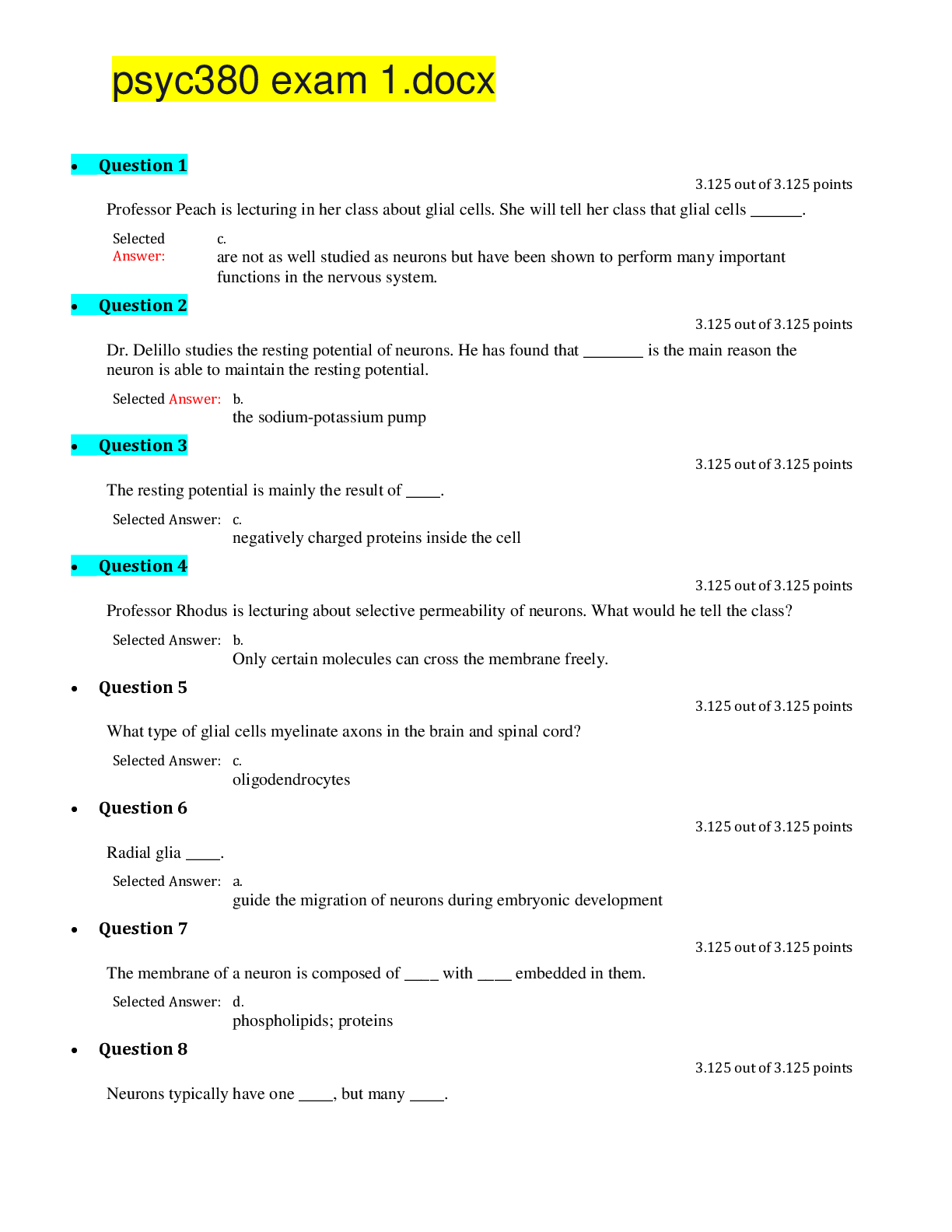
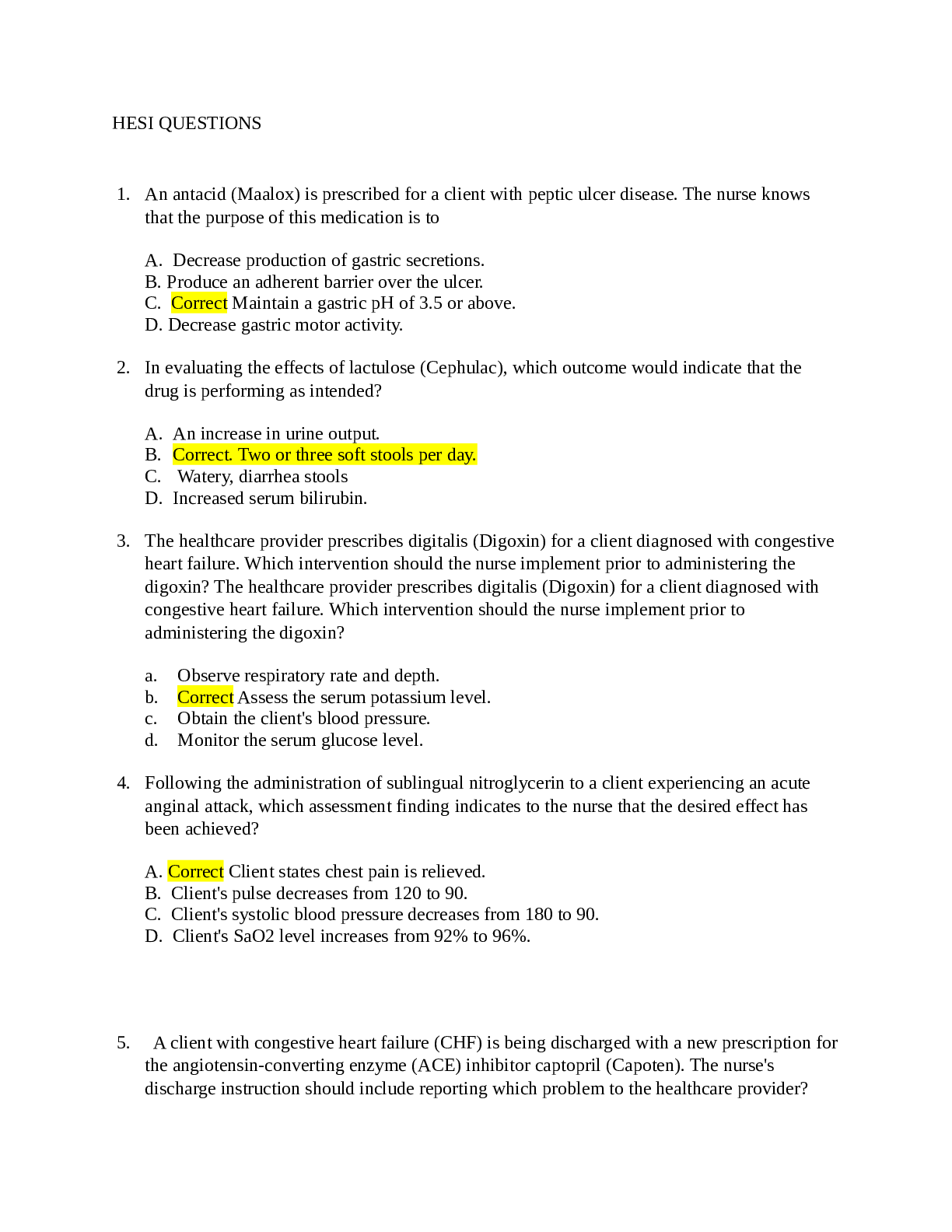



.png)













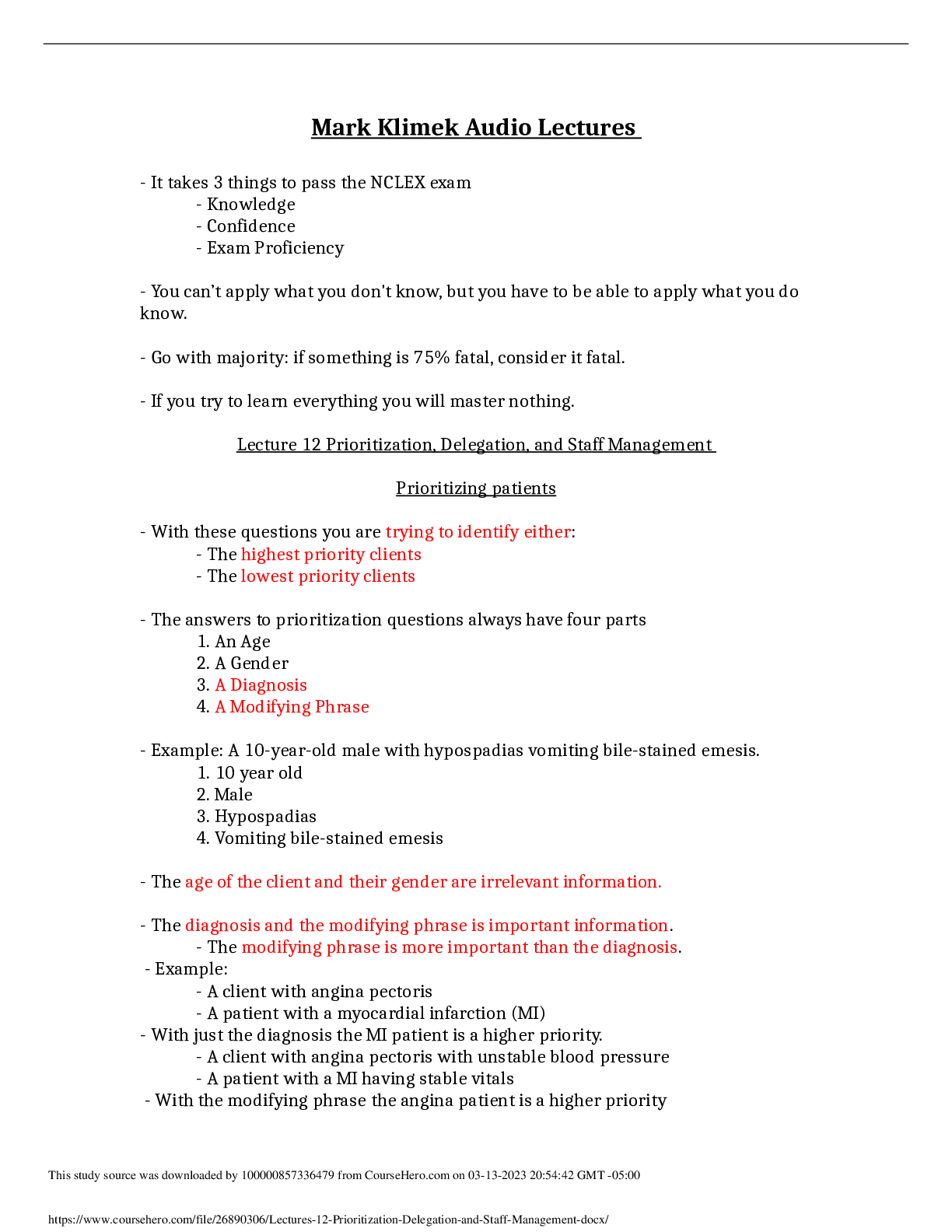



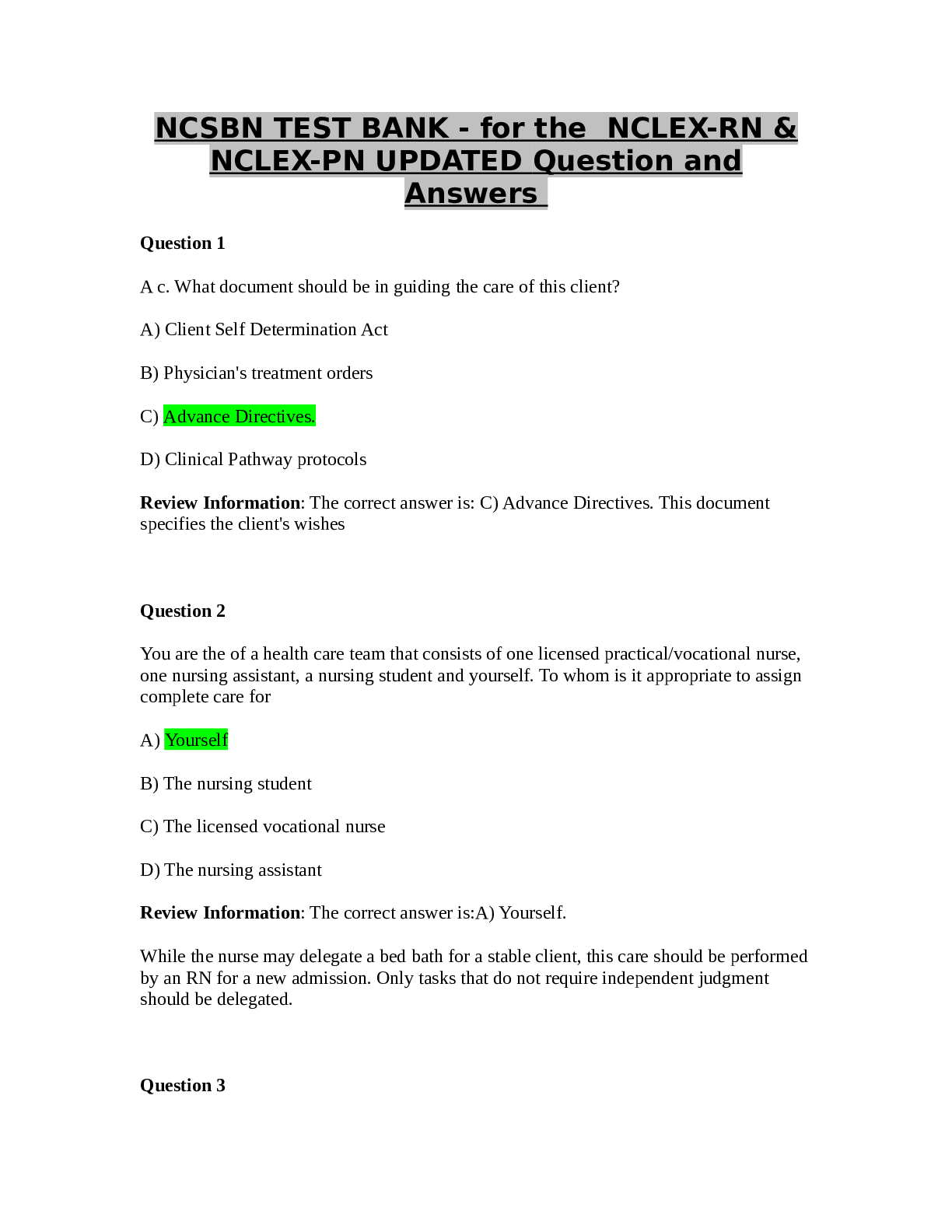
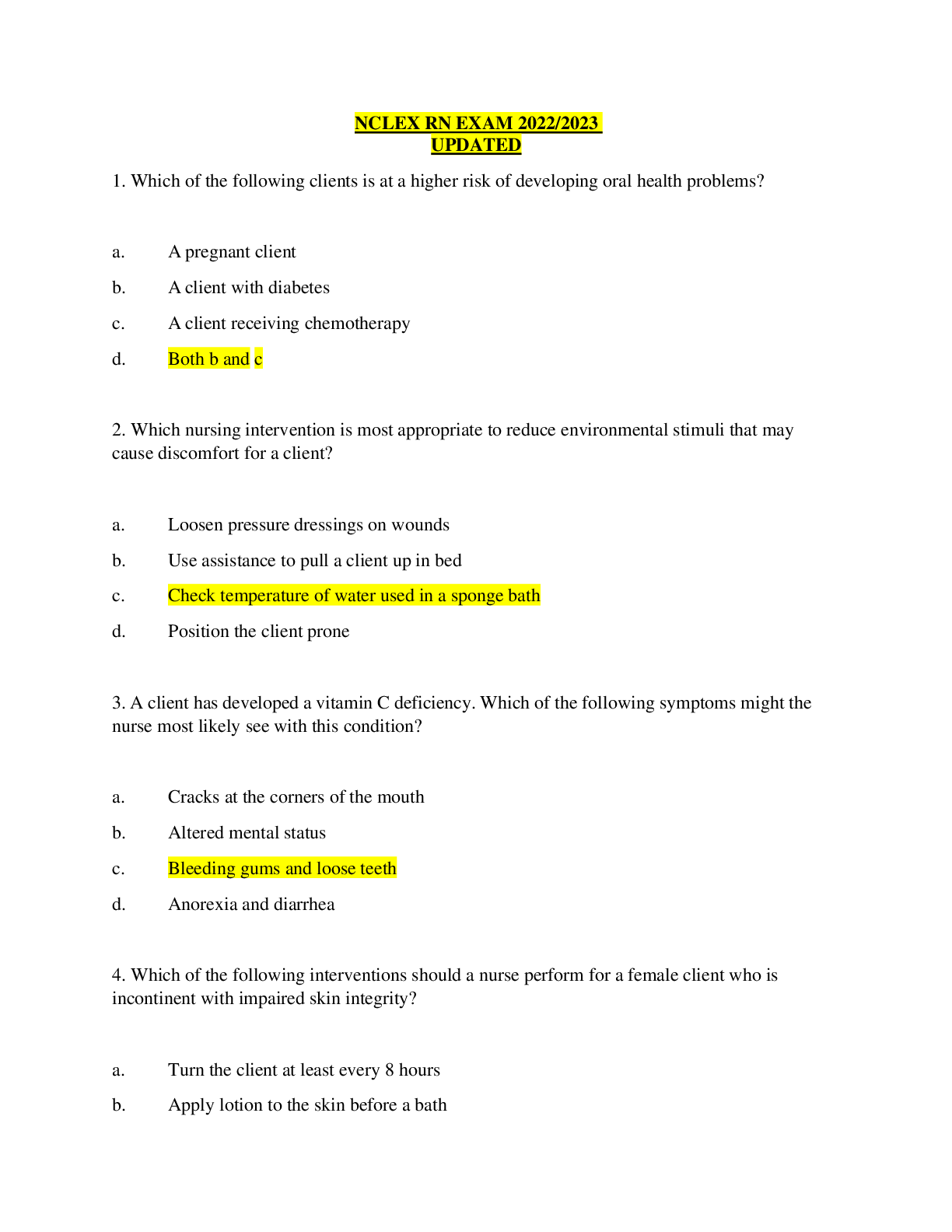
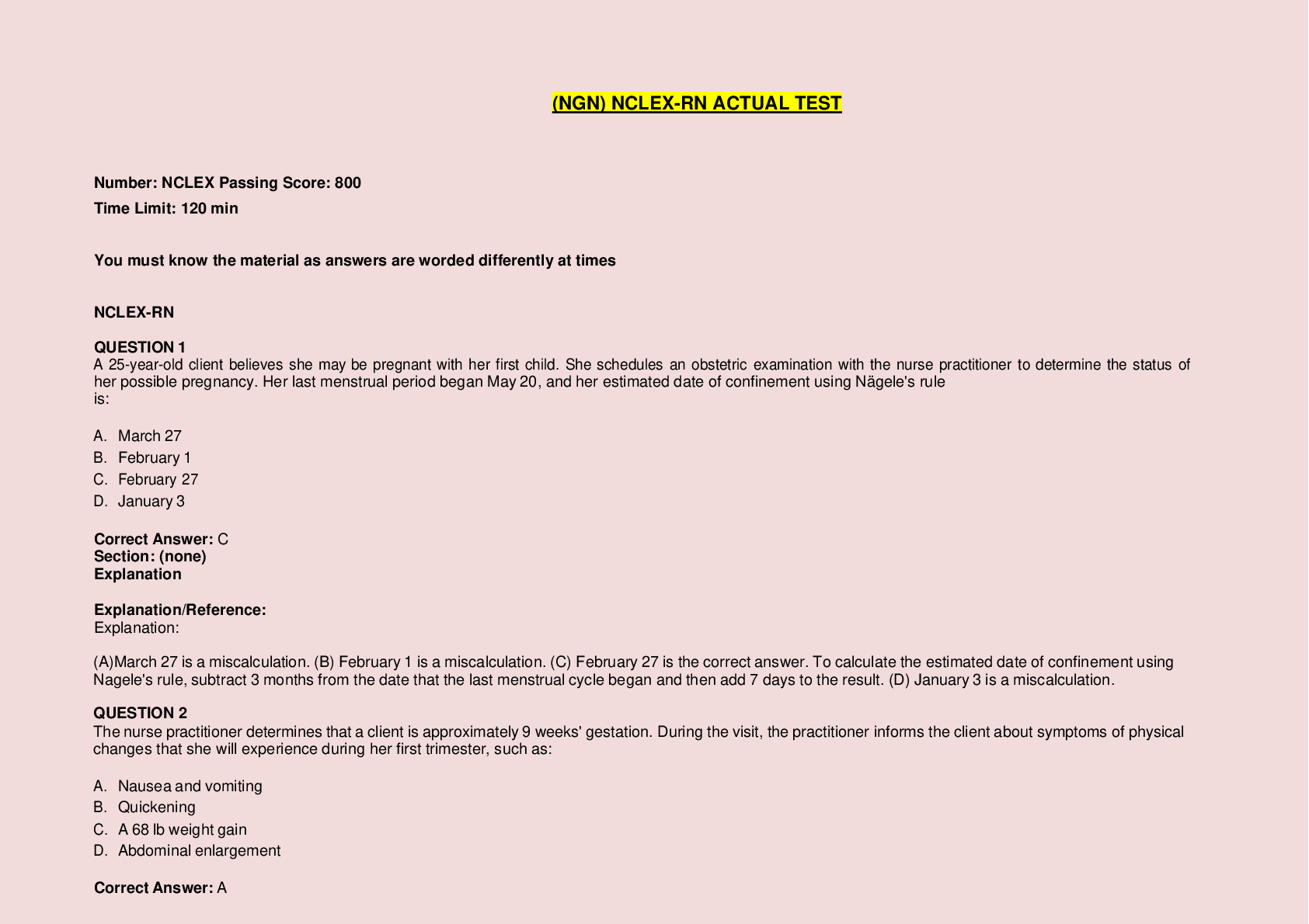
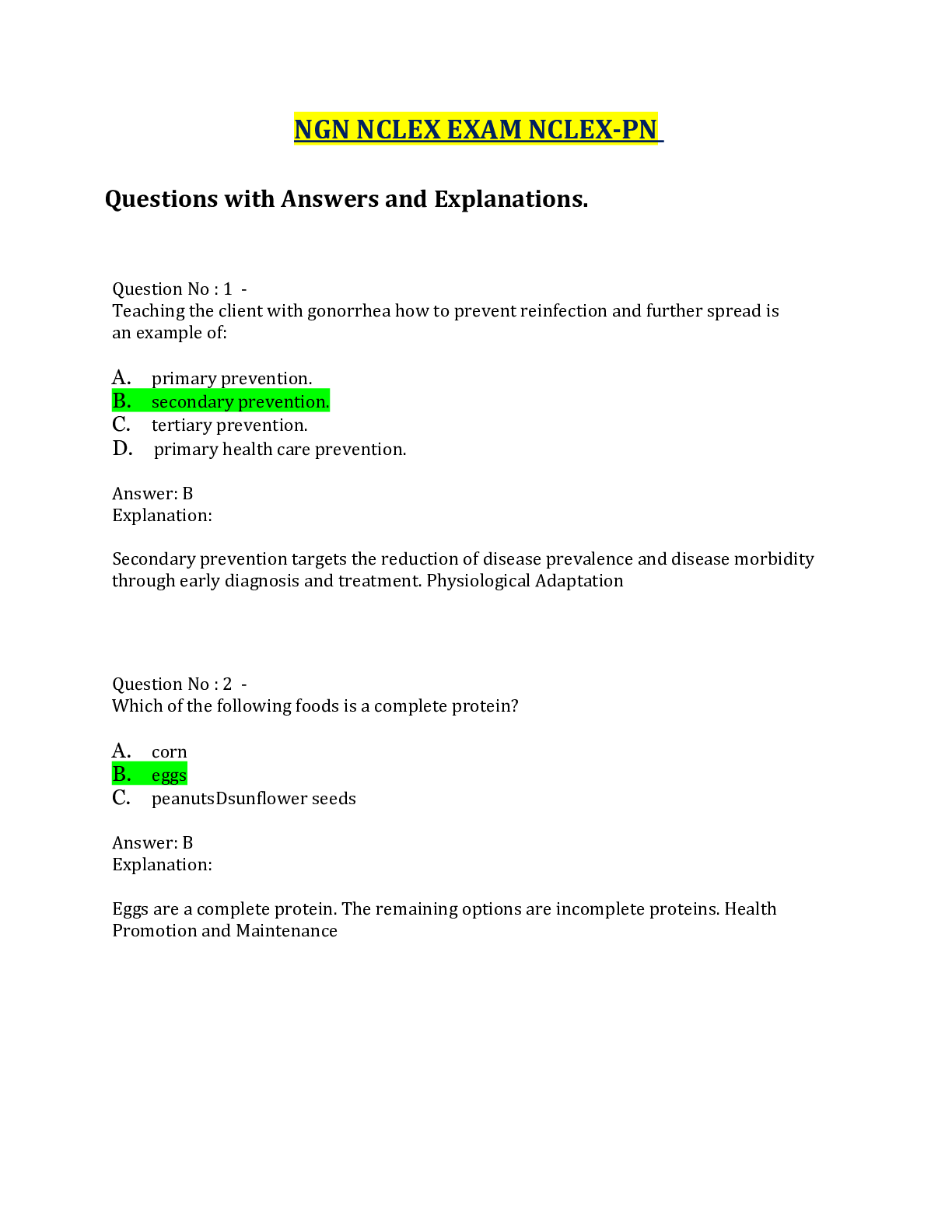

 JN21.png)

